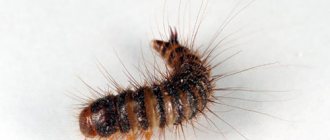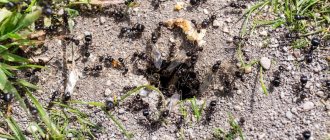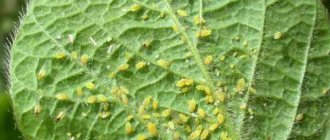Mole rat
The mole rat does not appear in the garden as often as a mole, for example, or a shrew, but it can cause much more damage to the crop. This rodent is capable of digging long tunnels, where it arranges special places for storing crops grown in the garden.
Getting rid of such a pest is not so easy and fighting it does not always have a positive effect. Sometimes you have to use a whole range of tools.
Introducing cats to hunt mole rats
First, you need to determine the location of the animal’s underground passages, which is not difficult to do, since in those places the earth collapses under your feet.
Using a shovel, dig about half a meter of underground tunnel. Since rodents are sensitive to the appearance of a draft, you will very quickly see a mole rat coming to fill the open part of the hole with earth.
Cats are natural hunters, but not all domestic animals are capable of catching mole rats.
At this time, there is no need to waste time - you need to dig a wide hole (up to half a meter) near the exit from the hole, the depth of which should be 30-40 cm, and then take your favorite pet and wait with it for the rodent to appear. If the mole rat is young, it is less agile, and catching it is not difficult.
By the way, you can also use the help of a dog to catch mole rats.
Reasons for appearance
This pest, like many others, is looking for something to profit from. Naturally, in their garden or summer cottage, the owners grow everything that is necessary to feed the mole rat. In addition to vegetables, there are worms and enough insects on the site. The higher the yield on the site, the greater the chance that this pest will appear here.
The mole rat does not hibernate during the winter, so it requires a lot of food. It is possible that the pest will definitely settle in the area where the crop is taken care of.
The activity of this pest leaves behind long, several-tiered passages in the garden, as well as underground storerooms in which the animal stores part of the crop grown by the owners in their gardens. As a rule, it eats the green mass first and stores the root crops for the winter. Even one mole rat is capable of taking away a considerable share of the harvest. If several individuals appear on the site, then you can forget about high yields of crops such as potatoes, onions, beets and carrots.
In addition, it digs quite large tunnels, with a diameter of 5 to 15 cm, due to which it damages some plants in the area. The lower tiers can be located at a depth of up to 3 meters, and the upper ones - at a depth of 10 cm. Such a system of underground passages often does not allow the normal development of many cultivated plants.
What kind of animal is this mole rat?
Few people know that there is also such a pest that can take away a significant part of the harvest from its owners. It is almost impossible to see it on the surface of the ground during such an activity as destroying crops.
Pest information:
- The pest can grow up to 30 cm in length.
- It has no eyes, but in their place there is a fold of skin, in the upper part of which hard hairs grow.
- The tail and ears are not large at all, and the front legs are short.
- The animal's fur has a dark gray tint with a blue tint, and adult individuals are distinguished by a characteristic "gray hair".
- The pest has powerful front incisors, which help it dig long underground passages. Only the 2 front incisors are clearly distinguishable.
- The pest digs long tunnels in several tiers.
- The animal's diet includes potatoes, carrots, beets, worms, insects, etc. Loves onions most of all.
- When a mole rat appears on a personal plot, it begins to destroy large plants, dragging them into a dug underground passage. After this, he eats the tops and places the root crops in his storage. Sometimes his storage facilities contain up to 50 kg of various root crops.
- It is not difficult to detect the presence of the animal if you pay attention to the peculiar mounds that look like the entrance to mole holes. Such mounds can be seen both in the garden and next to it.
How to get rid of mole rats on your property
Those who had to fight this rodent drew attention to the fact that the mole rat burrows quite deep into the ground, which complicates the fight against it. As already mentioned, the animal can burrow 3 meters deep, so in order to get it, you will have to dig up the entire area. In this regard, many owners are thinking about how to get rid of the animal in order to save the harvest. As you can see, the price of the issue is quite significant.
Experienced gardeners have tried a lot of methods and figured out how to get rid of such an unnecessary neighborhood. And here the most important thing is not to show excessive humanity, since several individuals with their cubs can deprive the owner of the harvest, especially since mole rats reproduce quite quickly.
Using traps
Traps are used to combat many rodents, including mole rats. But first, it’s better to determine who is spoiling the crop so that the effect of installing traps is maximum.
To fight effectively, the following steps should be taken:
Some owners tear up the soil and place containers with water inside multi-tiered passages, as a result of which the mole rats cannot get out. This is a rather labor-intensive process, since you have to dig deep into the ground. In addition, it is not always possible to obtain the desired result.
On a note! There is one, but effective way to get rid of such a neighborhood. To do this, you need to take a rag, soak it in gasoline, kerosene and other foul-smelling substances, and bury this rag in the ground at various depths. In addition, animals react negatively to essential oils of plants such as eucalyptus, cedar, lavender and others.
Ultrasonic repellers
Thanks to the rapid development of electronics, science and technology, it has been possible to create modern devices that emit ultrasonic waves of various frequencies. Humans do not perceive these waves, but many animals and rodents react negatively to ultrasound. Sound waves in this range cause a feeling of fear in rodents, as a result of which they begin to panic and try to leave the uncomfortable area as quickly as possible. Not much time passes, and the rodents leave this area in search of more comfortable conditions for their life.
For effective control it is necessary to install several such devices. In this case, it makes no sense to install any additional traps. Ultrasonic repellers will operate throughout the entire area. They will help get rid of pests even if a good, promising crop for rodents is ripening on the site. Such devices will help the owner get rid of other pests, not just mole rats. Moles, shrews, mole crickets and other pests cannot tolerate ultrasound. The main thing is to choose the right devices in terms of power so that they protect the entire area.
Source
How to get a blind man out of the garden using water
In order to catch a rodent, it is recommended to pour water inside the hole. You will need a lot of it, given the size of the underground dwellings. It is the mole rat's nest that needs to be flooded. Therefore, first you should find a passage where lumps of clay were thrown out along with the soil. The clay is located in the deep layers of the earth, so the chance that a rodent is here is quite high.
They clear the hole, open the entrance to the hole, and begin to water it with water from a hose. The disadvantage of this method is the need to kill the caught animal, which not everyone can do.
Another method of using water is very labor intensive. A trench 30 cm deep is dug around the circumference of the area. The edges are reinforced with slate or metal sheets so that once the animal gets inside, it cannot get out.
Inside the trench, holes are dug at a certain distance from each other and filled with water. Once in a trench, the mole rat moves along it, falls into one of the holes and drowns.
This method is good because you don’t need to look for the mole rat’s habitat, although you have to spend a lot of time and effort digging a trench.
How to quickly get rid of mole rats in your summer cottage
Let's start with the fact that mole rats and moles are different animals, but they cause almost the same damage to a summer cottage.
The mole rat belongs to the category of rodents and feeds exclusively on root vegetables. For him, carrots, beets, and potatoes are delicacies.
You can find animals in your garden through earthen mounds and deep tunnels into which you can even fall. Initially, many people think that moles are to blame, but there are other pests that are very similar to moles, since they do not see anything.
Let's find out what a mole rat looks like and how it differs from a mole. And also the question that interests us: “How to get rid of mole rats in the garden and summer cottage?”
Interesting facts about the rodent:
Mole rat in its habitat photo
- Mole rats are solitary animals. Adult mole rats live only in separate burrows. They are very careful and rarely fall into human traps.
- The mole rat can cause damage to agricultural crops in vegetable gardens and household plots. Soil emissions make it difficult to carry out field work, for example, mechanized mowing of perennial grasses for hay, and spoil field roads. At the same time, it is difficult to fight the mole rat due to its underground lifestyle. For this purpose, mechanical traps and repellent devices are used.
- The giant mole rat is a protected species listed in the Red Book of Russia and the IUCN Red List.
Description of an adult mole rat
The mole rat is a rodent and a fairly large one of its relatives. Its weight often reaches about 1 kg, and its body length is 30 cm. The animal has a large and flattened head, the ears are very small, and there is no tail at all.
The hairline is very tough, since long hairs sticking out in different directions act as organs of touch. Instead of eyes, individuals have dense skin folds that resemble closed eyes, but they are not there at all.
The rodent's lips are tightly compressed, thereby protecting the mouth from the entry of soil, but two incisors, which are very massive and long, protrude out. With their help, the mole rat does all the work underground in search of food, digs holes, and gnaws root crops.
The paws are very small and poorly developed.
The mole rat practically never goes outside and spends its entire life underground.
Habitat
Mole rats live in forest-steppe and steppe zones, not far from forest plantations and cereal crops. All subspecies of the mole rat, namely Bukovinian, Podolian, sandy and Pontic, are exhibits of the Red Book of Ukraine.
Therefore, it is generally accepted that the homeland and country of distribution of these rodents is Ukraine and its adjacent territories.
Every year the number of pest animals remains the same, and they are observed only on the right side of the Dnieper River, since they cannot overcome the width of the river.
What does it eat?
If there is no harvest on your plot, then you should not blame all the blame on the mole. We need to decide which crops are missing. If these are potatoes, beets and carrots, then this is definitely the work of the “teeth” of the mole rat.
In addition, the animal is not averse to eating bulbous crops, so flowers that have corms instead of roots may also suffer. The mole rat also eats the above-ground part of the plant, pulling the bush underground.
The pest's favorite greens are peas, beans, beans, and carrot tops. If the animal has enjoyed the grass, then it will prepare the root crop for future use.
It is known that an adult is capable of eating as much food per day as it weighs, therefore, when excavating its winter reserves, up to 18 kg of potatoes and other root crops were discovered in different compartments. Dry berries and nuts can be supplies for the winter.
Differences from a mole
The mole and the mole rat are completely different categories of animals.
They have some differences:
The blind animal digs very complex burrows, which have many branches and tiers, where the cubs, kitchen and pantries are located, in which supplies for the winter are stored.
How to recognize a pest?
The appearance of the rodent resembles a mole, but they cause much more harm to gardeners. Moles are mammals and feed on insects, but when digging they cause damage to plant roots. Mole rats are rodents; they eat various root crops growing on the site. They can also feed on plants; they will not even disdain onion flowers, which repel moles.
The animal has no organs of vision; where the eyes should be, it has a fold of skin covered with bristly hairs. The tail and ears are poorly developed. The body length of an adult mole rat can vary from 15 to 35 centimeters. Unlike the mole, it has small forelimbs. The main working tool of the pest are sharp teeth, or rather two protruding incisors. The remaining teeth are located inside, they are covered by multifold lips. It digs burrows in several tiers, the minimum depth of the burrows is usually 15 cm, and the maximum depth is three meters. The passages are quite spacious and can reach 12 cm in diameter; the mole rat needs this in order to move root crops along them.
The animal lives in the south of Russia, in the west of the Ciscaucasia, as well as throughout Ukraine. The mole rat is a mammal that belongs to the order of rodents, the mole rat family. They lead a predominantly underground lifestyle, and only occasionally come to the surface in search of food or a new place to live. In the countries of the former USSR, 4 types of mole rats are most common:
- giant;
- small;
- sandy;
- ordinary;
On the territory of Russia, you can most often see the common mole rat; it is also called small-eyed or South Russian. You can meet it both on your own site and in the forest-steppe zone, as well as on the edges and in the steppes. It lives in areas with herbal plants; the animal does not go far into the forest.
Interesting! Every year the number of mole rats is rapidly decreasing; “Giant” is even listed in the Red Book.
One single animal can cause enormous damage to a gardener; in the summer it mainly feeds on the above-ground parts of plants, but drags root crops into a hole, making reserves for the winter. In the animal's bins you can find up to 18 kg of various vegetables: beets, carrots, potatoes. It can harm not only garden crops, but also flowers, so gardeners should also be concerned when an uninvited guest appears. But what about several individuals or a family with offspring? Some sources say that in a day a blind person can eat as much food as he weighs. The mammal does not hibernate, but in the warm season it is more active.
These voracious animals do not have many enemies. In the wild, they often become prey for ferrets. Young individuals who are in search of a new habitat are often destroyed by foxes and birds of prey. On average, the lifespan of rodents is from 4 to 9 years.
Methods to combat mole rats
Due to the fact that the mole rat spends a long time in its burrows, it is very difficult to get rid of it. But still the fight against them is underway, the summer residents are using all sorts of weapons.
You can buy it at a veterinary store as a poison for rodents. Mole poison is also suitable.
Traps
Here you need to remember that if a young or adult inexperienced individual falls into a trap at least once, then the rest will be extremely careful.
The main thing in catching a rodent is to correctly select and install a trap or trap.
Sometimes a rodent is caught after half an hour, but usually these tricks are ineffective, since the pest has a colossal sense of smell and sense of smell and tries to bypass the traps.
We also recommend considering mole traps such as Supercat and Fedor the Cat - these are effective mole traps, but they can catch blind people on your property!
Follow the links to learn more about these traps and even place an order:
I will also leave links for residents of Ukraine:
Video review of the mole trap Cat Fedor
And here is a video of one gardener, where he tells his story of how he defeated moles
Repellers
As a repeller, you can use not only store-bought ultrasonic and vibration reflectors, but also homemade structures. Among them, excellent results are achieved by tin cans, which are placed on embedded sticks. When the wind blows, they create noise, crackling, ringing, which the animal does not like.
The mole rat, although a blind animal, has excellent hearing; when it hears extraneous sounds, it tries to retreat from its habitat.
Homemade products always bring success in the fight against rodents. If you installed one, but it did not work, you can make another one, taking into account all the characteristics and habits of the animal.
For hand-held devices, turntables and windmills are suitable, rattling in the wind and frightening the beast. You can learn how to make any design from the Internet, where experienced gardeners and gardeners share their advice.
Another frequently used way to drive an uninvited guest out of his lair is water. It is necessary to fill the hole with it until the animal begins to choke and crawls to the surface.
Conclusion
It is known that mole rats do not live in families, so if you managed to drive the pest away from your site, it may not appear for a long time. But if it appears again, then immediately begin to catch it, otherwise you may not find a crop in the garden beds in the fall.
In conclusion, it should be mentioned that an excellent way to combat rodents is to use cats and dogs, which are excellent catchers of large and small rodents, but this is not certain











